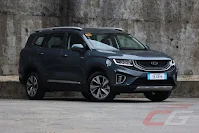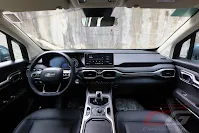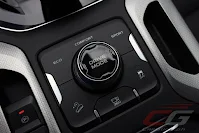The design brief of the Geely Okavango is odd, to say the least. It’s a mid-sized SUV, priced like a compact crossover, but rides on a platform shared with, of all things, an MPV. On paper, it’s an automotive mishmash of ideas—a product of corporate bean counters and FGDs (to some degree it is). In reality though, it could be your next family car.
As the largest vehicle ever to come from Geely, you’d expect the Okavango to be a large, lumbering beast. In reality though, its girth is more manageable—think Mazda CX-8. Its larger than life appearance is down mostly to its aesthetics. The simple lines and unbroken surfaces give it a sense of mass that won’t be possible if it were made too fussy.
On the flipside, this has decidedly made the Okavango the most reserved Geely vehicle to date. Compared to, say, the Coolray, things have been toned down by at least 50 percent; even the choice of colors reflect that. The single biggest design highlight, and perhaps the most controversial one, is the Skyline Roofrails—that’s saying a lot about its muted styling.
Whether you’re in Team Understated or Team Bland, one thing’s for certain: it’s well-kitted with enough kit to tickle the fancy of “porma” loving Filipinos. This top-of-the-line 1.5T Urban comes with full LED exterior lighting (including the fog lamps), 18-inch alloy wheels, and power folding mirrors and tailgate—it’s enough to pique your interest without going overboard.
Riding on the same platform as Geely’s MPV, the Jia Ji (no, it’s not using a Volvo-developed platform), the Okavango shows off its first party trick: easy entry. Despite a generous 194-mm ground clearance, getting into the driver’s seat is as easy as sliding your bum in.
Once aboard, you’re greeted to a wealth of space that’s, frankly, surprising given its modest exterior dimensions. Party trick number two is the Okavango’s packaging genius which extends all the way to the third row. The floor’s completely flat offering a sense of roominess that no other mid-sized SUV, even those from North America, can match. Even better, it’s extremely flexible. The second-row folds flat in an even three-way split, and even slides fore and aft, while the third-row folds down in a 50/50 split. The interior is so cavernous that Geely’s offering a unique genuine accessory: an inflatable mattress that perfectly molds around the wheel well and other protrusions. How you’ll use this inflatable mattress is best left to your imagination.
Going back to the driver, the Okavango’s flat, expansive dashboard isn’t just pleasing to the eyes, but it’s easy to use as well. Everything is corporate Geely—the digital gauge cluster, piano key-style climate control switches, electronic gear selector, and the tablet-style 10.25-inch touchscreen (sorry, still no Apple CarPlay or Android Auto here).
Interestingly, once you start poking around, you’ll begin to realize that the interior materials feel like half a step down even from the Coolray. For instance, despite the leather-like topper, the dash itself and door trims are plasticky, while the wiper and light stalks feel like something made by Fisher Price. There’s no panoramic sunroof (halleluiah), but the absence of any center overhead light is a constant reminder of what you’re missing. The seat mechanism used to enter the third row could use some work too. Though it’s a single lever action, it’s awkward to operate. More than once, it won’t catch the floor latch properly.
Those minor annoyances aside, the Okavango does deliver where it counts: the drive. Impressive NVH has always been a strong suit for Geely, but here it’s on a different level altogether. With no panoramic sunroof that could ruin rigidity, it quells even the worst of Manila’s potholes. It slides through cracks, imperfections, and what have you without disturbing the cabin’s Zen-like quality.
With its monocoque construction and MPV origins, the Okavango not only satisfies the common motorist, but even those who’d consider themselves enthusiasts. It’s rough at the fringes, but overall, it’s well-balanced. It even has driver-selectable drive modes, but leaving things in the default “Comfort” suits its character best. Of course, it can only mask the laws of physics so much: throw it into a corner, and it will exhibit copious amounts of body roll.
Despite sharing the Azkarra’s mild-hybrid system (190 horsepower, 300 Nm of torque), the Okavango behaves very differently, and differently in a good way. It doesn’t suffer the same low speed roughness and lag as Geely’s other mild hybrid. Instead, power is tractable, and more importantly, predictable. You can still catch the engine off-guard at times (it shuts off and allows you to coast as you come to a stop), but it fires back to life faster and less obtrusively than the Azkarra. Surprisingly, the 7-speed dual clutch is just as refined, even in stop-and-go traffic. It has none of the roughness commonly associated with this kind of gearbox.
Priced at P 1.328-million, the 7-seater Okavango is even more affordable than the smaller 5-seater Azkarra. Odd, right? On the surface, it’s hard to see how Geely’s able to come up with this price. The absence of that giant piece of roof glass aside, it’s got push-button start/stop with remote start, tri-zone climate control, powered front seats with tailgate; heck, it’s fully-loaded with safety too with 6 airbags, ABS with EBD, stability control, and even a 360-degree camera. Then, it hits you bit by bit—there are no vanity mirror lights, the rearview mirror’s manual, there are no front parking sensors—they’re not deal-breakers per se, but they are minor annoyances for people who’re used to a certain level of luxury.
This brings us back to where we all started: just what is the Okavango going against? At that price, with that size, and with those features, Geely is sending a message that it can cater to MPV, SUV, and even traditional sedan buyers. With that, they’ve gone for a message of distinction. And while that may be an exaggeration, you can’t deny that it does manage to whiff up a familiar, yet altogether segment-busting experience. It may be a product borne out of a focused group discussion, but for all its shortcomings and inconsistencies, it does fit the bill of the family car quite charmingly. In the end, that’s what matters.
|
2021 Geely Okavango 1.5T Urban |
|
| Ownership | 2021 Geely Okavango 1.5T Urban |
| Year Introduced | 2020 |
| Vehicle Classification | Mid-sized SUV |
| Warranty | 5 years / 150,000 kilometers |
| The Basic | |
| Body Type | 5-door SUV |
| Seating | 7 |
| Engine / Drive | F/F |
| Under the Hood | |
| Displacement (liters) | 1.5 |
| Aspiration | Turbo |
| Fuel Delivery | Direct Injection |
| Layout / # of Cylinders | I3 |
| BHP @ rpm | 190 @ 5,500 |
| Nm @ rpm | 300 @ 1,500-4,000 |
| Fuel / Min. Octane | Gasoline / 92~ |
| Transmission | 7 DCT |
| Cruise Control | Yes |
| Fuel Economy @ Ave. Speed | 7.51 km/L @ 15 km/h |
| Dimensions and Weights | |
| Length (mm) | 4,835 |
| Width (mm) | 1,900 |
| Height (mm) | 1,780 |
| Wheelbase (mm) | 2,815 |
| Curb Weight (kg) | 1,590 |
| Suspension and Tires | |
| Front Suspension | Independent, MacPherson Strut |
| Rear Suspension | Torsion Beam Axle |
| Front Brakes | Vented Disc |
| Rear Brakes | Disc |
| Tires | Continental ComfortContact CC6 225/55 R 18 V (f & r) |
| Wheels | Alloy |
| Safety Features | |
| Airbags | 6 |
| Anti-Lock Brakes (ABS) | Yes, with EBD |
| Traction / Stability Control | Yes |
| Parking Sensors | Yes, Rear, w/ 360 Camera |
| Front Seatbelts | 3-pt ELR with pre-tensioner x 2 |
| Rear Seatbelts |
3-pt ELR x 3 (2nd row), 3-pt ELR x 2 (3rd row) |
| ISOFIX Child Seat Anchor | Yes |
| Other Safety Features |
Hill Start Assist Hill Descent Control Tire Pressure Sensors |
| Exterior Features | |
| Headlights | LED |
| Fog Lamps | Yes, Front & Rear |
| Auto Lights | Yes |
| Rain-sensing Wipers | Yes |
| Interior Features | |
| Steering Wheel Adjust | Tilt/Telescopic |
| Steering Wheel Material | Leather |
| Seating Adjustment (driver) | Electric, 6-way |
| Seating Adjustment (front passenger) | Electric, 4-way |
| Seating Surface | Leather |
| Folding Rear Seat |
Yes, 33/33/33, Sliding
(2nd row), 50/50 (3rd row) |
| On-Board Computer | Yes |
| Convenience Features | |
| Power Steering | Yes |
| Power Door Locks | Yes |
| Power Windows | Yes |
| Power Mirrors | Yes, w/ Fold |
| Proximity Key | Yes |
| Climate Control | Yes, Tri-Zone, w/ Rear Vents |
| Audio System |
Stereo USB Bluetooth QDLink Smartphone Mirroring |
| # of Speakers | 8 |
| Steering Controls | Yes |


























And lastly, throw in the 5 yrs, 150k warranty the Japs must be having sleepless nights. Well, they won't admit it but they're sweating while denying.
ReplyDeleteAs soon as the warranty ends... I wonder how it will hold up. Hmmmm....
Deleteyou can always rely on the user's review back in Malaysia, Indonesia and China. Geely is backed with Sojitz and with it's reliable world track record. The backend is not the issue. Volvo uses their engines too, you haven't heard from their customers complaining like Mitsubishi car owners.
DeleteDo hybrid vehicles get bigger tax breaks in the TRAIN law?
ReplyDeleteBigger winners under the TRAIN Law are purely electric vehicles and pickup trucks, which are now EXEMPT from tax on automobiles. ... Generally, the TRAIN Law increased the excise tax rates on automobiles to generate revenue for the government's infrastructure, health, education, employment, and social programs.Compared to regular automobiles, “Hybrid Vehicles” are subject to only 50 percent of the excise tax rates imposed by the TRAIN Law. ... Bigger winners under the TRAIN Law are purely electric vehicles and pickup trucks, which are now EXEMPT from tax on automobiles.
DeleteHonestly? I would consider this...
ReplyDeleteThis New Geely Vehicle will hit home run against its Price competitors perinnial Leader Mitsubishi Expander, the Toyota Rush, Honda BR-V and Suzuki XL7. It will outmatch them in all terms of measurements.
ReplyDeleteDo we need special batteries in hybrid vehicles? Does it mean that hybrid motor turns on first before the mechanical motor engines every time we turn to start the car?
ReplyDeleteHybrid batteries are in-house with it's own warranty. For your second question, it always depends on how much energy is stored in its batteries through regenerative braking. I also heard this version is milder in regenerative braking compared to the Azkarra so definitely you'd be using your engine more often.
DeleteDo we need special batteries in hybrid vehicles? Does it mean that hybrid motor turns on first before the mechanical motor engines every time we turn to start the car?
ReplyDeleteIt requires a regular 12-volt battery. The traction motor uses the small lithium-ion battery to power it up, but gasoline engine and other electronics still uses the 12-volt lead-acid battery. This setup is the same with any hybrid or even EV.
Delete*most EVs.
DeleteWhat if that small ev conks out will the car still works? And just how long does the ion lithium batt last?
DeleteIn the Okavango's setup, the hybrid can't pull the car using its own power. It's more of a power assist. For sure there will be a safe mode of some kind though.
Deletehmmm, like to see a comparison bet Okavango 1.5T Urban and Montero GT..or Fortuner..
ReplyDeleteThat fuel economy though, bad I would say. My xpander gets around 8 to 10 in 15 kph.
ReplyDeleteit's relatively larger, heavier and more powerful because of its turbo that's why. Naturally aspirated engines are still more reliable when it comes to fuel efficiency. Your expander and other NA engines of it's category were designed to be fuel saver. Congratulations on your purchase by the way.
Deleteany idea how long will it takes the Okavango working? like the other engine type atleast even 10 years still working
ReplyDeleteGeely is pretty young and the Volvo partnership is even younger. So they really need to prove that. Hopefully, it turns out good, because they make good cars. But that engine had already won several awards in racing, so I think it's good enough.
Deletefor a gasoline type engine, is the fuel economy good or bad?
ReplyDeletehi how about the major parts in philippines?
ReplyDelete